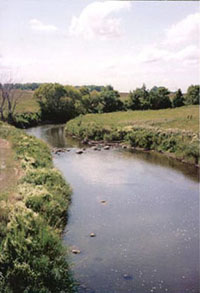Minnesota Water Science Center

ABOUT THE MINNESOTA
|
Effects of Agricultural Land Retirement in the Minnesota River Basinby Victoria G. Christensen and Kathy E. Lee.  West Fork Beaver Creek. Three watersheds in the Minnesota River basin were selected to study effects of agricultural land retirement on stream quality. Site selections were based on similarities in hydrology, land use, soil type, and other characteristics; and differences in land retirement percentages. Water samples were collected from 2005-2008 and analyzed for field measurements, nutrients, and sediment. Streamflow and continuous water-quality data also were collected. Biological sampling was conducted in August 2006 and 2007. The South Branch Rush River (representing little to no land retirement) had substantially higher nitrogen concentrations than Chetomba Creek and West Fork Beaver Creek, watersheds with more riparian land retirement. Total phosphorus was highest in West Fork Beaver Creek and lower in Chetomba Creek and South Branch Rush River. A second monitoring site was established in Chetomba basin, downstream from substantial riparian land retirement. Nitrite plus nitrate, total nitrogen, and total phosphorus were lower for the downstream monitoring site, which may indicate that water-quality improved due to land retirement. Fish data indicate better resource quality for West Fork Beaver Creek than other streams likely due to several factors including habitat quality, food resources, and dissolved oxygen characteristics. Index of biotic integrity scores increased as local land-retirement percentages (50-and 100-ft buffers) increased. |